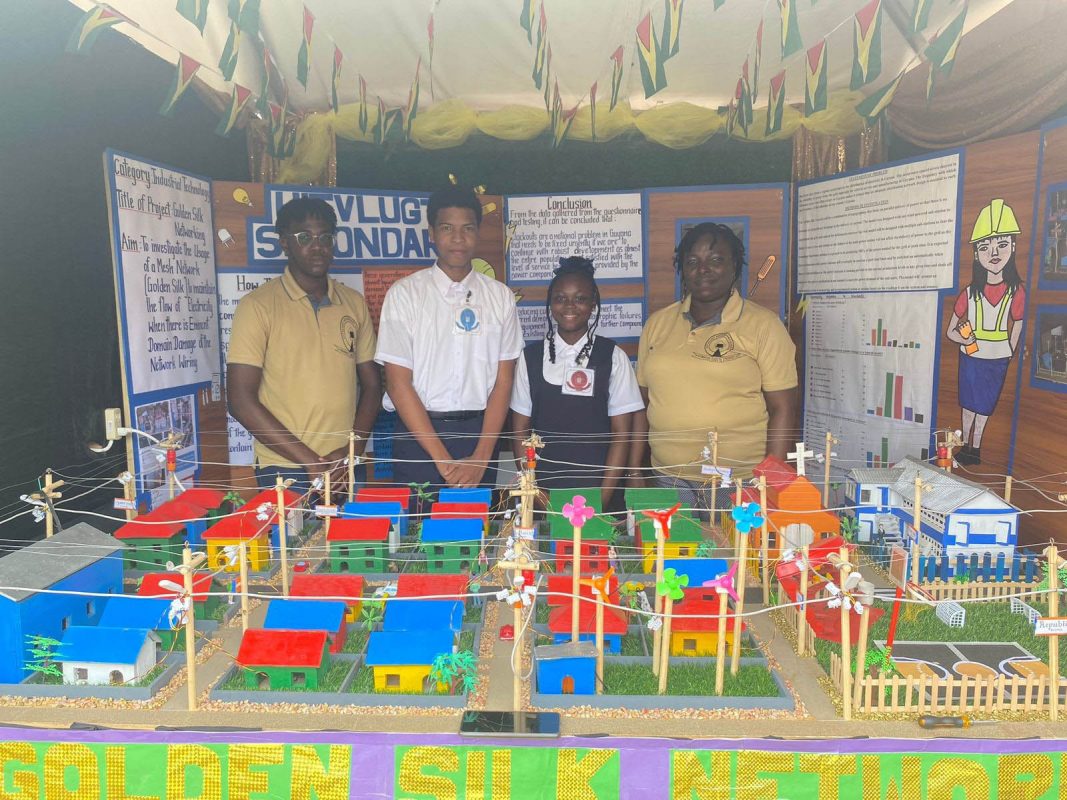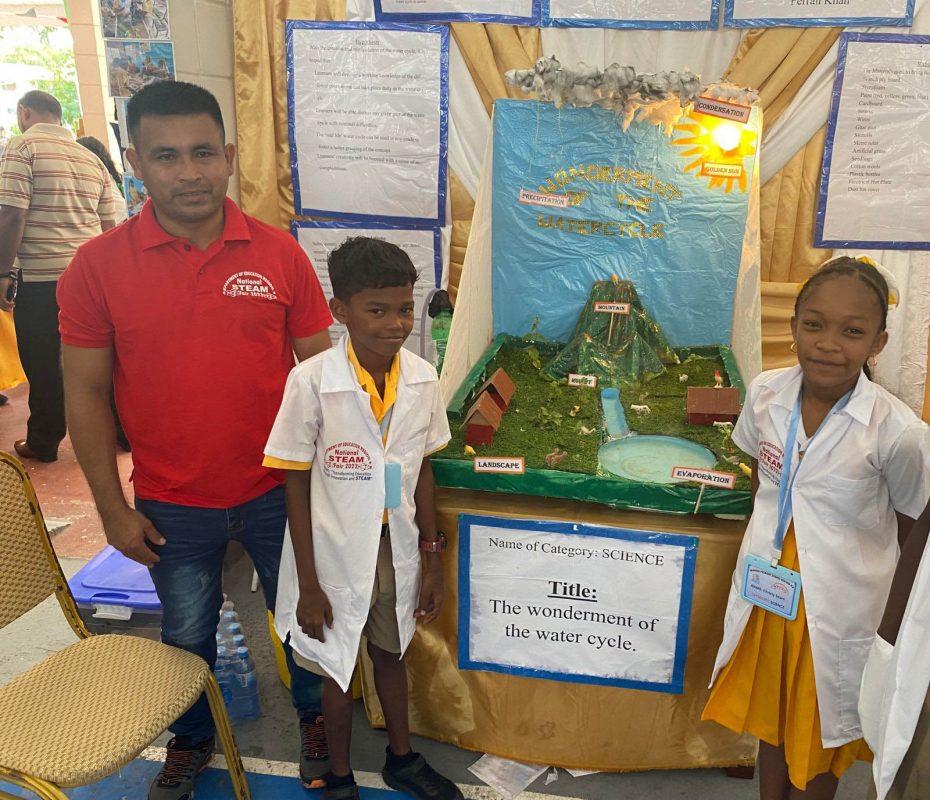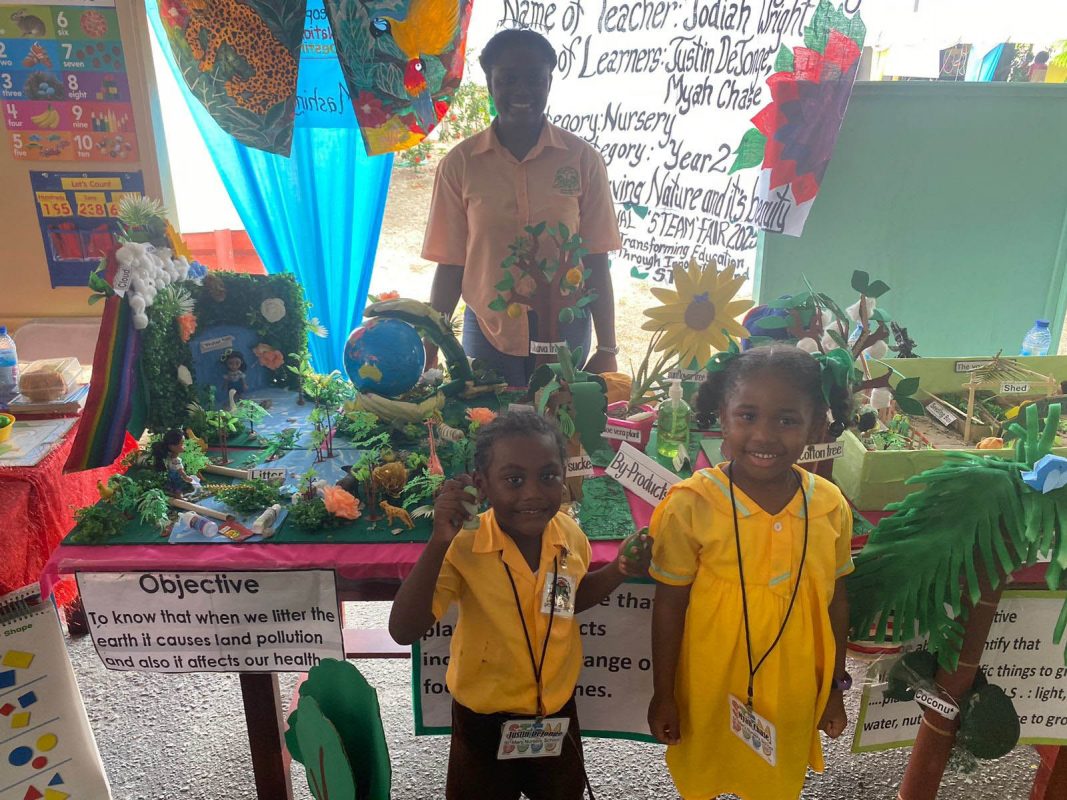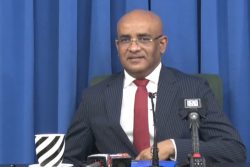The three-day National Science, Technology, Engineering, Arts and Mathematics (STEAM) Fair which ended yesterday saw renewable energy and conservation among the projects showcased and Regions Two and Four did exceptionally well.
The Ministry of Education yesterday said that Region Two emerged as the overall champion district in the Primary category while Region Four captured the overall prize in the Secondary category. (The full results are below)
After a five-year hiatus, the fair was held at the Cyril Potter College of Education, Turkeyen under the theme, “Transforming Education through Innovation and STEAM.” Over two hundred and fifty projects were prepared culminating with the best projects in each category, a total of 117, being formally presented for judging.
Stabroek News visited the fair on Tuesday and had an opportunity to engage with pupils, students, teachers and education officials. Two students from Uitvlugt Secondary School, Akeelah Glasgow, 15, and Joshua Melville, 16, told Stabroek News that the title of their project was Golden Silk Networking.
“With this network we are using wind turbines which power the grid transferring energy to the substation where electricity is being stored. Golden Silk Networking is there to provide electricity even when there is a power outage”, the students said. Their teacher told this newspaper that the school’s exhibit was a product of both teachers and students and the materials used were sand paper to build roads, phone wires, sanitary plates, bamboo sticks and a computer to do the coding. Their exhibit included a replica of their school and a church.
Miss Marissa, a teacher from Stanford Primary School, her two pupils, Aayden Hope, 11, and Joel Semple, 10, told Stabroek News that their project was based on generating electricity from two sources of energy: water and wind.
“When the wind from the two fans hits the blade of the wind turbine they start to spin continuously and send kinetic energy to the motors in the wind turbines” they explained. Miss Marissa added that the materials used to make their school’s exhibit were plywood [to build the road], popsicle sticks to make the fence, recycled cans, plastic bottles, corks from plastic bottles, spray paint to colour, batteries and switches to make a circuit.
Christy Sears, 11, and Ferran Khan, 11, of Mahdia Primary School, told Stabroek News that their project was “The Wonderment of the Water Cycle”, demonstrating the elements of the water cycle which are evaporation, condensation and precipitation. Their teacher, Kelly Brasche, told this newspaper that the materials they used to make their projects were plywood, kite paper, artificial grass and cotton to make clouds amongst other materials.
Two pupils of Skeldon Primary School, Talique Griffith and Timothy Hari both aged 11, told Stabroek News that their exhibit emerged from a rule that plastic cannot be disposed of in bins at their school. Hence, the title of their project was “Reusing and Recycling of the Plastic Waste”. Under the Craft and Visual category, Judy Kendall told this newspaper that plastic cups, fairy lights, plastic spoons, a light bulb and socket were used for the project. She also noted that plastic waste can also be recycled for a wide range of decorative items both indoors and outdoors.
Two pupils from St Mary’s Nursery School, Myah Chase, 5, and Justin Dejonge, 4, told this newspaper that preserving nature and its beauty was their project.
“We started with germination and we know when we plant we get things from these seeds like vegetables, clothing etc., so we moved on to caring for the plant, they are different ways in which we can care for plants which include giving the plant adequate exposure to sunlight so that photosynthesis can take place, then we would have moved on to the by-products, so when we care for those plants by giving them the various things they need we can have food, medicine, clothing and even shelter. We then moved on to pollution which is not something nice and in order for us to have a cleaner and greener Guyana we need to put some recycling” said the teacher of St. Mary Nursery School, Jodiah Wright. The pupils added that the materials they used to make their project were cardboard, toy frogs, spray paint, foam and boxes.
Senior Education Officer, Navendra Hardyal told Stabroek News on Tuesday that he was elated to see such participation from all eleven education districts. “We are showcasing over 177 projects, besides that we have non-governmental and governmental organizations taking part in the Science Fair, after a series of fairs during the month of March we culminated with the finals at the Cyril Potter College of Education.”
He added, “This fair has three components which we judged, namely the booklets which were judged on the 28th and 29th of March by a team of judges, which was out of 67 marks, the oral presentations where one participant from the project goes before a panel of judges and explains what their project is about which was out of 37 marks and the judging of the booth is 38 marks and in total 142 marks.”
The STEAM fair results as provided by the Ministry of Education
Lower Secondary School
Mathematics
1st Anna Regina Secondary School – The BIDMAS Spin
2nd West Demerara Secondary School – Mathematics Dominoes
3rd Annandale Secondary School – The use of the balance method when solving algebraic equations
Lower Secondary School
Integrated Science
1st Queen’s College – Organic Hair Care
2nd Anna Regina Secondary School – Home-made fibre brickettes
3rd North West Secondary School – Filtration and Conservation of Water for Domestic Use
Lower Secondary
Craft & Visual Arts
1st St. Cuthbert’s Secondary – Entrepreneurship through cultural creativity
2nd Harmony Secondary School – Wonders of the Scleria Secanas
3rd Queen’s College – Re-Vamp
Lower Secondary
Agricultural Science
1st St. Rose’s High School – Benefits of Cassava
2nd Wakapoa Secondary School – Herbal Happiness’
3rd North West Secondary School – Value-added products
Lower Secondary
Information Technology
1st Berbice High School – Smart Traffic light
2nd St. Rose’s High School – EZY SUBMIT
3rd North West Secondary School – Enhanced learning using hologram
Lower Secondary
Environmental Science
1st Manchester Secondary School – Water Desalination
2nd Anna Regina Secondary School – An environmentally friendly oil spill dispersant
3rd West Demerara Secondary School – Phytoremediation of GreyWater
Lower Secondary
Social and Behavioural Science
1st Cotton Field Secondary School – The effects of cyberbullying on students
2nd Karaudarnau Primary School – Earnestly Eco
3rd Covent Garden Secondary School – Sound Proof Headphones
Lower Secondary School
Home Economics
1st Paramakatoi Secondary School – A pinch of cassareep
2nd New Campbellville Secondary School – Coconut Seasoning
3rd Covent Garden Secondary School – Nine-layer density liquid powder
Upper Secondary School
Mathematics
1st Annai Secondary School – Math Jeopardy
2nd West Demerara Secondary School – Graph paper effectiveness
3rd Diamond Secondary School – The Matic boy
Upper Secondary School
Integrated Science
1st Friendship Secondary School – Green Village
2nd Santa Rosa Secondary School – Wind Turbine
3rd Woodley Park Secondary School – Production of Biochar from agricultural residues for waste treatment
Upper Secondary School
Environmental Science
1st Tutorial High School – Promoting science through technology
2nd Bush Lot Secondary School – Fat to Fuel
3rd Karasabai Primary (Secondary Department) – Eco–Friendly Environment
Upper Secondary School
Craft and Visual Arts
1st President’s College – Natural Inks
2nd Bygeval Secondary School – Emerge Suckers
3rd Leonora Secondary School – Recycled materials to create Art
Upper Secondary School
Agricultural Science
1st Covent Garden Secondary School – Drip irrigation system for future advancement
2nd ISA Islamic Academy – Wifi Controlled Garden
3rd No. 8 Secondary School – Domestic chicken plucker machine
Upper Secondary School
Information Technology
1st Abrams Zuil Secondary School – Augmented Reality in education
2nd Covent Garden Secondary School – Smart Classroom
3rd Linden Foundation Secondary School – The content tracer
Upper Secondary School
Social and Behavioural Science
1st Tucville Secondary School – The Mamee influence
2nd Bladen Hall Secondary School – The Journey of Comprehenders
3rd Linden Foundation Secondary School – Partners in Line
Upper Secondary School
Home Economics
1st President’s College – Using local and organic produce to prepare instant baby and toddler food
2nd New Amsterdam Secondary School – Kin and Carica products stopping food shortage
3rd Maruranau Primary (Secondary Dept) – Chikiziba – Magic Flavour
Upper Secondary School
Biology
1st Aurora Secondary School – Biology processor
2nd Skeldon Line Path Secondary School
3rd Bladen Hall Secondary School – Making of a beauty product
Upper Secondary School
Chemistry
1st Brickdam Secondary School – Development of bar hand soap
2nd Mackenzie High School – Dust no more
3rd Abrams Zuil Secondary School – CO2 Must Go
Upper Secondary School
Physics
1st Marian Academy – The Future of energy
2nd Santa Rosa Secondary School – Observing Newton’s third law of motion the rocket
3rd New Amsterdam Secondary School – The Bookscavator
Upper Secondary School
Industrial Technology
1st Cotton Field Secondary School – Producing lightweight and cost-effective blocks using rice hull ash
2nd DC Caesar Fox Secondary School – Hydropower
3rd Bladen Hall Secondary – Engineering design and furniture making
Primary
Mathematics
1st C.V Nunes Primary
2nd Regma Primary
3rd Virginia Primary
Primary
Environmental Science
1st Sparta Primary
2nd Cane Grove Primary
3rd Wismar Hill Primary
Primary
Science
1st Coomaka Primary
2nd Sandvoort Primary
3rd Hampton Court Primary
Primary
Craft and Visual Arts
1st Skeldon Primary
2nd Aurora Primary
3rd Muritaro Primary
Open Category
1st Marian Academy – Kanesthetics
2nd New Amsterdam Secondary School – Biodegradable Eraser (Bio-Rase)
3rd President’s College – WASP (Wind and Solar Powered) car charging station














